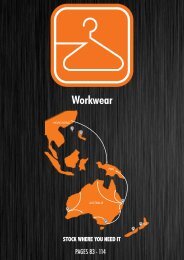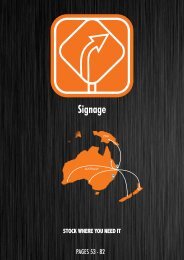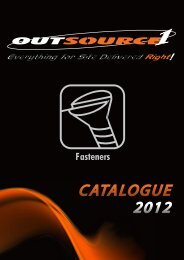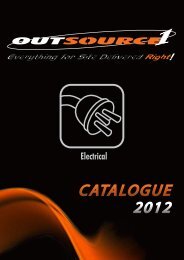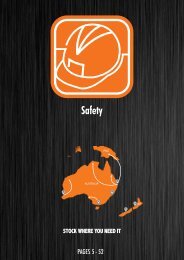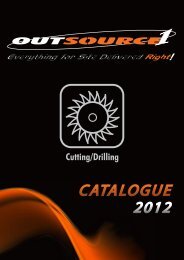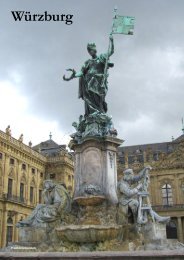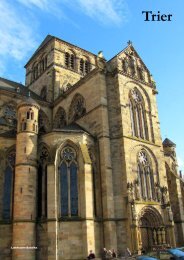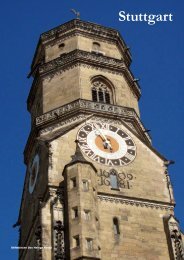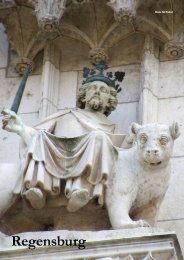Raven Guides: Germany - Nuremberg
Create successful ePaper yourself
Turn your PDF publications into a flip-book with our unique Google optimized e-Paper software.
<strong>Nuremberg</strong><br />
Sinwellturm
The Sebalder Altstadt, foreground, at the foot of the<br />
castle Kaiserburg, maintains its late medieval profile.<br />
<strong>Nuremberg</strong> (Nürnberg)<br />
<strong>Nuremberg</strong> is famous for several<br />
reasons but much of its old centre<br />
remains as a monument to a late<br />
medieval world when a thriving<br />
middle class led it to a cultural and<br />
commercial peak.<br />
As a free imperial city, <strong>Nuremberg</strong>’s medieval<br />
relationships with the German crown were<br />
close. The first castle had appeared on the<br />
hill in the mid 11th century and Frederick<br />
Barbarossa built up an imperial castle from<br />
the middle of the 12th. At the end of his reign<br />
the Hohenzollern burgraves arrived as its new<br />
stewards.<br />
The city, walled but divided by the river<br />
Pegnitz and with separate parish churches,<br />
was granted its charter and free status in 1219.<br />
In 1356 the first imperial diet or Reichstag<br />
was held there with the edict that each new<br />
emperor should hold his first Reichstag in<br />
<strong>Nuremberg</strong>. Its wealth was largely due to its<br />
trading position near the centre of Europe and<br />
the commercial class dominated city affairs.<br />
But <strong>Nuremberg</strong> was in other respects<br />
divided. It became one flashpoint of the<br />
massacres that spread from the Hohenlohe area<br />
in 1298. Anti-Jewish sentiment had developed<br />
over a decade and a mob leader known as<br />
Rintfleisch led pogroms in various parts of<br />
Franconia. He assaulted <strong>Nuremberg</strong>’s castle,<br />
where citizens had tried to protect the Jewish<br />
community, and led a slaughter of hundreds.<br />
Rintfleisch was eventually hanged but<br />
about the time of the Black Death in 1348 a new<br />
push to remove Jews from their quarter in the<br />
town centre around the river was launched. It<br />
is clear some of the prime movers were in debt<br />
to Jewish lenders, but the Jewish community<br />
had also lined up against the emperor Charles<br />
IV in his conflict with German throne claimant<br />
Günther von Schwarzburg.<br />
The emperor approved the destruction of the<br />
Jewish quarter to build a central marketplace<br />
and church and in the eviction that followed<br />
about one-third of the community of about<br />
1500 were killed. Survivors could not return<br />
for three years. Further, the building of mighty<br />
city walls enclosing the castle led to disputes<br />
between the town and the burgraves and<br />
the dukes of Bavaria attacked the castle. By<br />
then also lords of the Mark Brandenburg, the<br />
Hohenzollerns eventually cut their losses and<br />
sold the ruined castle to the city. There was a<br />
further Jewish expulsion in 1499, after which<br />
the Jewish community did not re-establish<br />
itself in the city until the 1850s.<br />
Also around the time of the plague the<br />
crafts sector revolted against a lack of civic<br />
rights but was suppressed and fobbed off with<br />
token seats on the city council.<br />
Despite this political strife <strong>Nuremberg</strong>,<br />
behind its strong defences, was to make<br />
strides in art, science and publishing. Apart<br />
from the high art of sculptors such as Veit Stoß<br />
and Peter Vischer the elder, there emerged<br />
a giant – the artist, printer, mathematician<br />
and chartmaker Albrecht Dürer, perhaps the<br />
leading Renaissance painter north of the Alps.<br />
Astronomy was in vogue and the <strong>Nuremberg</strong>er<br />
Martin Behaim developed instruments for<br />
the Portuguese navigation revolution (and,<br />
on returning to <strong>Nuremberg</strong>, possibly the first<br />
world globe). The city was to become a leader<br />
in the manufacture of clocks, especially pocket<br />
watches, and toys.<br />
The city never wanted for stories.<br />
Meistersinger were poets drawn from the<br />
social ranks of artisans and commercial<br />
firms, established in a tradition of performing<br />
mainly for the middle class rather than the<br />
courtly audiences of the high medieval period.<br />
But their poetry followed some medieval<br />
precedents and intricate rules and was marked<br />
accordingly in keen public competitions. The<br />
performers’ hierarchy from master to novice<br />
reflected artisan guild practice. In the 16th<br />
century, under the shoemaker Hans Sachs,<br />
the <strong>Nuremberg</strong> Meistersinger were the preeminent<br />
practitioners of the art in <strong>Germany</strong>.<br />
Richard Wagner, in composing his opera<br />
Die Meistersinger von Nürnberg, was drawn<br />
to their story by the middle-class status of the<br />
artists and their audience. Despite its moments<br />
of farce and nationalist subtext, his work<br />
celebrated the society that sustained the poetic<br />
tradition. Today a monument to Sachs and this<br />
lost age stands at Hans-Sachs-Platz.<br />
The Reformation arrived in 1525, which<br />
estranged the city from the Catholic imperial<br />
crown. Although occupied by Swedes and<br />
besieged by Wallenstein’s imperial forces the<br />
city, with a third wall reinforced to include<br />
its now signature round towers, served<br />
<strong>Nuremberg</strong> well during the Thirty Years War.<br />
But plague, which returned several times in the<br />
16th and 17th centuries, exacted its own toll<br />
and sea travel provided a bypass for the land<br />
routes critical to <strong>Nuremberg</strong>’s trade. The 17th<br />
and 18th centuries were depressed economic<br />
times for the city and as a result the Baroque<br />
largely passed <strong>Nuremberg</strong> by.<br />
In 1806 the city joined the new Bavaria,<br />
which agreed to accept its civil debts.<br />
But industry was to underpin its return to<br />
prominence. The first German railway opened<br />
© 2014 RAVEN TRAVEL GUIDES GERMANY<br />
RAVEN TRAVEL GUIDES GERMANY - <strong>Nuremberg</strong> 1
The Justizpalast,<br />
scene of the<br />
<strong>Nuremberg</strong> trials,<br />
allows access to<br />
the world’s most<br />
famous<br />
courtroom and a<br />
museum about<br />
the proceedings<br />
and their<br />
aftermath.<br />
The Sinwellturm<br />
of the<br />
Kaiserburg,<br />
below, the best<br />
viewpoint over<br />
the city.<br />
RAVEN QUICK GUIDE<br />
Tourist information & accommodation service: Königstraße 93 (tel 0911-23360, M-Sa<br />
9-19, Su 10-16); Hauptmarkt 18 (May-Oct & Dec M-Sa 9-18, Su 10-16, Nov & Christmas-<br />
Apr M-Sa 9-18).<br />
Money: ReiseBank, Hauptbahnhof (M-Sa 7.30-19.45, Su 8-12.30, 13.15-16); VR-Bank,<br />
corner Königstraße and Bankgasse (M-F 10-19, Sa 10-16); Commerzbank, Königstraße 21<br />
(M-W 9.30-17, Th 9.30-18, F 9.30-15.30).<br />
Lockers: Hauptbahnhof basement (€5/3 per day).<br />
Transit information: VAG-KundenCenter, Königstorpassage (M-F 7-20, Sa 9-14); VGN, DB<br />
Reisezentrum, Hauptbahnhof (M-F 6-21, Sa 8-18, Su 10-21).<br />
Post: Bahnhofsplatz 1 (M-F 8.30-19, Sa 9-14); Äußerer Laufer Platz 24 (M-Sa 9-20);<br />
Josephsplatz 3 (M-F 9-18.30, Sa 9-14); Jakobsplatz 3 (M-F 9-18.30, Sa 9-14).<br />
Internet: Coffee Fellows, Hauptbahnhof upper level (M-Sa 6.30-22, Su 7.30-22).<br />
Laundry: Eco-Express Waschsalon, Schweiggerstraße 32 (M-Sa 6-23); Nürnberger SB-<br />
Waschsalon, Sulzbacher Straße 86 (M-Su 6-23); Schnell und Sauber, Schwabacher Straße<br />
86 (M-Su 6-22).<br />
Police: tel 110; Jakobsplatz 5 (tel 0911-21120); Theresienstraße 2 (tel 0911-20607);<br />
Wallensteinstraße 47 (tel 0911-65830).<br />
Pharmacy: Apotheke im Hauptbahnhof, Bahnhofsplatz 9 (M-F 6-20, Sa 8-18); Mohren-<br />
Apotheke zu St Lorenz, Königstraße 32 (M-F 8.30-19.30, Sa 9-18); Spital Apotheke zum<br />
Heiligen Geist, Spitalgasse 2 (M-F 8-19, Sa 8.30-19); Kugel-Apotheke, Rathausplatz 5 (M-F<br />
9-18.30, Sa 9-16).<br />
Ambulance: tel 112.<br />
The Gänsemännchenbrunnen (c1550) at<br />
Rathausplatz once graced the goose market.<br />
Hospital: Klinikum Nürnberg Nord, Haus 20, Prof-Ernst-Nathan-Straße 1 (tel 0911-3980);<br />
Klinikum Nürnberg Süd, Bauteil A, Breslauer Straße 201 (tel 0911-3980); Kliniken Dr Erler,<br />
Kontumazgarten 4 (tel 0911-2728220).<br />
to Fürth in 1835 and a new momentum<br />
of machinery and technology gathered.<br />
A <strong>Nuremberg</strong> company merged with an<br />
Augsburg concern in 1898 to create the MAN<br />
company.<br />
The city’s imperial background proved an<br />
attraction for 20th century nationalists. Nazi<br />
rallies were held outside <strong>Nuremberg</strong> from<br />
1927 and the laws revoking Jews’ German<br />
citizenship were named for the city after<br />
Hitler proclaimed their importance at a 1935<br />
rally. Allied air raids culminated in the city’s<br />
near-annihilation at the start of January 1945<br />
and amid the rebuilding the city’s court was<br />
chosen to host the 1946 war crimes trials.<br />
Lorenzer Altstadt<br />
Most of the sights are enclosed by 5km of<br />
medieval walls and ditches and powerful<br />
gate towers. The old parish divisions are<br />
preserved by the Pegnitz running east-west<br />
through the middle and the churches of St<br />
Lorenz and St Sebald still brand the two<br />
precincts. To explore the Lorenz or southern<br />
part, much of it a pedestrian zone, start at the<br />
round tower Frauenturm next to Königstraße<br />
at the south-east corner near Bahnhofsplatz.<br />
The Handwerkerhof is on the left – follow<br />
Königstraße to Hallplatz, where the Mauthalle<br />
is on the left. Further on the Lorenzkirche<br />
marks Lorenzplatz.<br />
Crossing the river to the north, the<br />
Museumsbrücke offers the best view of the<br />
medieval Heilig-Geist-Spital to the right.<br />
Over the Pegnitz is Hauptmarkt with the<br />
Frauenkirche and Schöner Brunnen as focal<br />
points. From Schöner Brunnen turn back south<br />
and cross the river again at Fleischbrücke.<br />
Turn right at Kaiserstraße, which curves<br />
south to become Färberstraße, where the<br />
pedestrian zone ends at Brunnengasse. To the<br />
south, turning east, Kurt-Schumacher-Straße<br />
becomes Kornmarkt. Kartäusergasse runs<br />
south past the Germanisches Nationalmuseum<br />
as an avenue celebrating human rights.<br />
Frauentormauer to the left follows the inside<br />
of the medieval wall line back to Königstor.<br />
Sebalder Altstadt<br />
From Hauptmarkt the visitor can explore the<br />
northern half of the old centre. North and to<br />
the rear of the Frauenkirche Obstmarkt, then<br />
Fünferplatz, run past the oldest facades of the<br />
Altes Rathaus north to Theresienstraße. Turn<br />
left for 100m, then north again at Burgstraße<br />
to pass the gabled Fembohaus and arrive at the<br />
foot of the castle at Am Ölberg.<br />
Follow the inside of the wall southwest<br />
to Tiergärtnertor and exit the old city<br />
through the gate. From here, a walk east along<br />
Vestnertorgraben gives a sense of the might<br />
of the twin wall network and a path makes it<br />
possible to enter the moat. Even 150 years ago<br />
the full city wall circuit was like this.<br />
Back inside Tiergärtnertor is the Albrecht-<br />
Dürer-Haus and Neutormauer leads past<br />
the round Neutor to Maxplatz. Turn east<br />
before following the half-timbered street<br />
Weißgerbergasse to Weinmarkt, where the<br />
towers of St Sebald are straight ahead. From<br />
its portal Winklerstraße leads south and<br />
Schulgäßchen leads around its south side back<br />
to the Rathaus. From Rathausplatz turn south<br />
back toward Hauptmarkt.<br />
Information<br />
Nürnberg Info is at Königstraße 93 and<br />
<strong>Nuremberg</strong> 2 - RAVEN TRAVEL GUIDES GERMANY
The preserved<br />
medieval features<br />
of the Hohenstaufen<br />
Kaiserburg (Apr-<br />
Sep M-Su 9-18,<br />
Oct-Mar M-Su<br />
10-16, museum<br />
€7/6 with tower<br />
view, visitors<br />
under 18 admitted<br />
free) are due to the<br />
crown’s loss of<br />
interest in the<br />
city after the<br />
Reformation. The<br />
earliest of the<br />
present structures<br />
is the Kapelle<br />
(c 1200), of which<br />
there are lower and<br />
upper sections, the<br />
latter with an imperial gallery and limewood crucifix by Veit Stoß. The Kaisersaal, used<br />
for receptions, and the Rittersaal, for assemblies of the Reichstag, are on different levels.<br />
The Heidenturm is also from this period, along with the footings of the mighty round<br />
Sinwellturm, but the Sinwellturm’s present upper tower is (along with the nearby well<br />
house) from the 16th century. The tower is the place to survey the layout of the<br />
fortifications as well as take in the city view. The Burggrafenburg was in the lower area<br />
next to the present access ramp but is much reduced by the destruction of 1420. Take tram<br />
4 to Tiergärtnertorplatz or bus 36 to Burgstraße.<br />
After the castle passed into the control of the city<br />
the moat that separated the two was no longer<br />
needed. It was filled in and the Kaiserstallung<br />
(1495) by Hans Beheim was built as a corn<br />
storehouse on the site between the earlier eastern<br />
watchtower Luginsland (1377, part of the town’s<br />
defences) and the pentagonal tower (of early but<br />
uncertain date). In the 16th century it began to be<br />
used as stables, but today it is the DJH hostel. The<br />
towers were used as prisons from the 15th century.<br />
Beheim proved himself master of techniques for<br />
buildings that were large for the time, including<br />
the Heilig-Geist-Spital and Mauthalle. Take tram 4<br />
to Tiergärtnertorplatz or bus 36 to Burgstraße.<br />
The half-timbered buildings of<br />
Weißgerbergasse leading to the<br />
Weinmarkt give the best impression<br />
of a complete half-timbered street.<br />
More than 20 preserved buildings<br />
toward the west end are artisan<br />
homes, as opposed to those of the<br />
commercial classes. To judge from<br />
the street name tanneries were the<br />
dominant businesses, probably those<br />
producing fine leather. The buildings<br />
range from the 15th to 17th centuries,<br />
providing a mixture of features. Take<br />
bus 36 to Am Hallertor.<br />
The Albrecht-Dürer-Haus at Albrecht-Dürer-<br />
Straße 39 near the castle stands as a memorial to<br />
the figure most identified with the northern<br />
Renaissance. Born to an immigrant Hungarian<br />
goldsmith, Dürer went on to study painting and<br />
engraving as an apprentice and set up his own<br />
workshop by 1494. He travelled several times but<br />
bought this c1450 Gothic house in his home town<br />
in 1509 and lived there until his death in 1528. The<br />
building, close to original appearance but<br />
refurnished, houses the Dürer museum including<br />
displays of the master’s work spaces (see<br />
Museums). His statue is nearby at Albrecht-Dürer-<br />
Platz. Take bus 36 to Weintraubengasse.<br />
Hauptmarkt 18. During the Christmas markets,<br />
November 29 to December 23, the Hauptmarkt<br />
office is open M-Sa 9-19, Su 10-19. Nürnberg<br />
Info is at Königstraße 93 and Hauptmarkt 18.<br />
During Christmas markets, November 29 to<br />
December 23, the Hauptmarkt office is open<br />
M-Sa 9-19, Su 10-19. At Königstraße the<br />
attached Kulturinformation Nürnberg centre<br />
has information about culture and events.<br />
The tourist information website is tourismus.<br />
nuernberg.de.<br />
For walking around the sights, Nürnberg<br />
City Guide (€5) from Schöning Verlag has all<br />
the background. <strong>Nuremberg</strong>: The medieval<br />
city – a short guide (€6.80) by Martin Schieber<br />
brings excellent insights into the history<br />
behind the sights. The <strong>Nuremberg</strong> Trials: A<br />
short guide (€6.80) backgrounds the post-<br />
World War II war crimes prosecutions.<br />
For literature in English or maps and<br />
guidebooks, Hugendubel is at Ludwigsplatz 1.<br />
Freytag & Berndt (M-Sa 10-18) at Königstraße<br />
85 specialises in maps and travel guides of<br />
diverse types. Korn & Berg (M-F 9.30-18.30,<br />
Sa 9.30-18) at Hauptmarkt 9 has guidebooks<br />
and maps including city maps. For literature<br />
on arts and culture a Cedon shop is in the<br />
Germanisches Nationalmuseum.<br />
Transport<br />
Rail: The Deutsche Bahn Reisezentrum at<br />
the Hauptbahnhof (M-F 6-21, Sa 8-18, Su 10-<br />
21) handles ticket sales but there is a separate<br />
information desk (M-Su 6-24) for other<br />
inquiries. The only toilets in the vicinity open<br />
during daylight are in the Königstorpassage,<br />
north of the station under Bahnhofsplatz.<br />
Multiple daily rail services, including fast<br />
trains, run from Würzburg (about 55 minutes)<br />
and Frankfurt (two hours 10 minutes).<br />
Hourly expresses arrive from Regensburg<br />
(about one hour) with links to Passau as well<br />
as regional trains (also hourly). Fast expresses<br />
to and from Munich (70 to 75 minutes) are<br />
regular daily, sometimes travelled at 300km/h.<br />
Fast expresses also arrive from Leipzig and<br />
Berlin several times daily.<br />
DB regional trains also serve Amberg daily<br />
(about 50 minutes) at intervals varying from 40<br />
to 70 minutes. Rothenburg ob der Tauber can<br />
be reached by using three trains and changing<br />
at Neustadt an der Aisch and Steinach.<br />
Expresses to and from to Vienna/Wien<br />
(four hours 45 minutes) via Linz run four<br />
times daily, as well as trains with a few more<br />
stops. A true overnight journey to Vienna is<br />
not available, although a nightly EuroNight<br />
train leaves <strong>Nuremberg</strong> just after 3.20 to arrive<br />
in Vienna just before 9.00. There are several<br />
daily direct rail services to and from Prague/<br />
Prag (three hours 40 minutes) by DB’s IC Bus<br />
or the Czech Student Agency Bus.<br />
Bus: Long-distance buses use the central<br />
bus station (ZOB) adjoining Bahnhofstraße at<br />
Käte-Strobel-Straße east of the Hauptbahnhof.<br />
Overnight Eurolines buses to London leave<br />
three times a week (M, W & F 21.15). Overnight<br />
buses to Paris leave three times a week<br />
and to Prague 25 times a week. The Eurolines<br />
ticket office is adjacent to the stops. Buses to<br />
eastern European and Balkan countries are<br />
many.<br />
Services to other German cities include<br />
the daily Berlin Linien Bus services to and<br />
from Munich (two hours 20 minutes) and the<br />
FlixBus services to Berlin, Munich, Frankfurt<br />
and Stuttgart. The Eurolines-Touring Munich<br />
RAVEN TRAVEL GUIDES GERMANY - <strong>Nuremberg</strong> 3
Another example of a <strong>Nuremberg</strong><br />
merchant-class residence is the late<br />
Gothic Fembohaus (1596) at<br />
Burgstraße 15. But it is atypical in<br />
having its gable face the street. The<br />
building was given Baroque decorative<br />
touches in the 17th and 18th<br />
centuries, but on the whole the city<br />
was set against opulent exteriors. The<br />
city’s history museum inside (see<br />
Museums) provides an opportunity to<br />
view the interiors, including the dance<br />
hall. Take bus 36 to Burgstraße.<br />
The Altes Rathaus has both late Gothic (c1515) and<br />
Italian Renaissance facades, the latter marked by the<br />
ornate doorways. The Renaissance part (1622) was<br />
completed by the elder and younger Jakob Wolff, though<br />
due to the Thirty Years War not to the scale they had<br />
envisaged. The council was dominated by the merchant<br />
class to the practical exclusion of the artisans, who<br />
maintained only a token presence. The Gothic Große<br />
Rathaussaal (1340) upstairs was for the time a<br />
surprisingly large pillarless chamber, redecorated in 1520<br />
with designs by Albrecht Dürer that were badly damaged<br />
by bombing. The medieval dungeon below can be visited<br />
(see Museums). Take bus 36 to Hauptmarkt.<br />
The Tucherschloß was built at<br />
Hirschelgasse 9 north-east of the city<br />
walls in garden surroundings early in the<br />
16th century by one of the established<br />
and successful <strong>Nuremberg</strong> commercial<br />
families. The Renaissance exterior<br />
was according to custom restrained by<br />
comparison with the inner decoration.<br />
The residence museum (see Museums)<br />
puts this on show, along with the opulent<br />
Hirsvogelsaal (1534), reconstructed using<br />
fragments placed in storage before<br />
bombing destroyed a nearby building.<br />
Take bus 36 to Innerer Laufer Platz.<br />
The elder of the two great parish churches, the St-Sebald-<br />
Kirche facing Weinmarkt, was the earliest place of worship<br />
for the upper town patriciate. Its 13th century kernel is late<br />
Romanesque and the high Gothic choir and much of the<br />
stained glass is from the mid 14th century. Notable works<br />
from the great <strong>Nuremberg</strong> artistic period are many: Peter<br />
Vischer and sons’ tomb for St Sebald (1519) and the Veit<br />
Stoß crucifixion with Mary and Joseph (1520) are just two.<br />
The towers were raised to 75m in the 15th century. There<br />
was a Baroque makeover during the 17th century and later<br />
<strong>Nuremberg</strong> organist Johann Pachelbel became cantor. War<br />
damage required much reconstruction, refurbishment is<br />
ongoing and a donation of €1 is requested from visitors.<br />
Take bus 36 to Hauptmarkt.<br />
The Gothic fountain Schöner Brunnen (c1380) at<br />
the Hauptmarkt is a 1900 replica of the original now<br />
held in the Germanisches Nationalmuseum. Its many<br />
figures at various levels depict biblical personalities,<br />
a cast of ancient and medieval heroes and the seven<br />
liberal arts. The wrought iron<br />
around it (1587) is by Paulus<br />
Kuhn. The apparently<br />
seamless 5cm brass ring<br />
worked into it is<br />
unsurprisingly the subject<br />
of fable and considered a<br />
lucky charm. Take bus 36<br />
to Hauptmarkt.<br />
service runs twice daily and the Frankfurt<br />
service daily. MeinFernbus runs Berlin (five<br />
hours 20 minutes), Dresden, Stuttgart and<br />
Mannheim (three hours 25 minutes) services.<br />
Air: Direct flights from London City Airport<br />
are available to and from <strong>Nuremberg</strong> (take U2<br />
to Flughafen).<br />
City transit: <strong>Nuremberg</strong> stands at the centre<br />
of the extensive Verkehrsverbund Großraum<br />
Nürnberg (VGN) regional network, closely<br />
linked with the neighbouring cities Fürth and<br />
Erlangen. Four S-Bahn lines operate, the S1<br />
north to Bamberg (just under an hour) via<br />
Fürth and Erlangen. This is additional to DB<br />
regional trains on the line.<br />
The Verkehrs-Aktiengesellschaft Nürnberg<br />
(VAG) operates the Nürnberg-Fürth U-Bahn,<br />
tram and bus network. There are five U-Bahn<br />
lines, the U2 servicing the airport. Five tram<br />
lines run outside the Altstadt through inner<br />
districts, three through Bahnhofsplatz at the<br />
Hauptbahnhof north exit.<br />
Local buses 43 and 44 stop outside the<br />
Hauptbahnhof. A separate network of 15<br />
Nightliner night buses (coded N, www.vagnightliner.de)<br />
operates between 1.00 and<br />
4.00 (to 5.00 weekends and before holidays)<br />
from the Hauptbahnhof and others service<br />
Fürth and Erlangen. A sightseeing bus (bus<br />
36, running between the U-Bahn station<br />
at Plärrer and Großer Dutzendteich) links<br />
sights of interest in and beyond the Altstadt<br />
including Hauptmarkt, Altes Rathaus, the<br />
Albrecht-Dürer-Haus, the Meistersingerhalle<br />
and Dokumentationszentrum Reichsparteitagsgelände.<br />
Two basic VGN fare zones apply in<br />
<strong>Nuremberg</strong> and Fürth. One-way journeys<br />
with the necessary changes of mode or line,<br />
valid for 90 minutes in the inner zone, cost<br />
€2.50/1.20 (children are under 15). Strip tickets<br />
valid for five journeys cost €7.30/3.70 for the<br />
<strong>Nuremberg</strong> inner zone, €11.30/5.70 using both<br />
zones. The strip tickets can be stamped for<br />
more than one traveller on the same journey.<br />
One traveller can buy an unlimited day ticket<br />
for €5.10 (if bought on Saturday this will be<br />
valid on Sunday as well).<br />
Families (or groups with only two travellers<br />
18 or over) should use the basic group day<br />
ticket at €8.50 (a ticket at €16.80 will be valid<br />
for travel to Bamberg, Amberg or Rothenburg<br />
ob der Tauber). A one-week unlimited card is<br />
available at €21.90.<br />
For ticket or general inquiries and<br />
timetables the VAG-KundenCenter (M-F 7-20,<br />
Sa 9-14) is in Königstorpassage, outside the<br />
Hauptbahnhof. The VAG website www.vag.de<br />
has an English section and there is a telephone<br />
hotline (tel 0911-2834646). VGN operates the<br />
website www.vgn.de and Info-Telefon hotline<br />
(tel 0911-2707599) and has service counters<br />
in the DB Reisezentrum at the Hauptbahnhof<br />
(M-F 6-21, Sa 8-18, Su 10-21).<br />
Taxi: Taxis arrive to the right of the<br />
Hauptbahnhof north exit or at the car park of<br />
the south exit. To order call tel 0911-19410.<br />
Bicycle: NorisBike (tel 0911-2834646, M-F<br />
7-20, Sa 9-14), part of the Nextbike system,<br />
has a bicycle hire station at the west end of<br />
the Hauptbahnhof building at Bahnhofsplatz.<br />
The system, which operates using cards<br />
and a multilingual touch screen, has a basic<br />
cardholder rate of €9 per day. Partner of Sports<br />
(M-F 10-19, Sa 10-15, tel 0911-538530) at<br />
Rennweg 7 offers basic rental bicycles in<br />
summer at €5 per day, others from €15 a day.<br />
<strong>Nuremberg</strong> 4 - RAVEN TRAVEL GUIDES GERMANY
MUSEUMS & GALLERIES<br />
There is a broad array of <strong>Nuremberg</strong> museums, including a clock museum, a fire brigade<br />
museum, a pigeon museum and a children’s museum. To examine these in English go<br />
to the Museums tab under the Sightseeing menu at tourismus.nuernberg.de or the city<br />
museums site www.museums.nuremberg.de.<br />
All museums can be visited free by holders of the Nürnberg Card (see right). For<br />
other visitors some combination tickets are available: those who pay €2.50 extra at<br />
Dokumentationszentrum Reichsparteitagsgelände, Memorium Nürnberger Prozesse,<br />
Stadtmuseum Fembohaus, Museum Industriekultur or Tucherschloß can visit any other<br />
museum free on the same day. At some museums there are two family rates depending on<br />
whether there are one or two adults. A few open Mondays during Christmas markets.<br />
English audio guides are available as MP3 files under the Sightseeing menu (Museums tab)<br />
at the tourist office website for the following museums: DB Museum, Albrecht-Dürer-Haus,<br />
Lochgefängnisse, Spielzeugmuseum, Fembohaus and Neues Museum.<br />
For cultural history, Germanisches Nationalmuseum (Tu & Th-Su 10-18, W 10-21,<br />
€8/5, families €10) at Kartäusergasse 1 is probably <strong>Germany</strong>’s best general museum and<br />
certainly one of the biggest. Archaeology, art including works by Dürer, a wide collection of<br />
musical and scientific instruments, period dress and home interiors arranged by themes are<br />
just some of the collections. Especially relevant to <strong>Nuremberg</strong> are the toys and guild history<br />
collections. Wednesday evening admission is free but the extraordinary weapons and<br />
armour collection is closed at this time.<br />
A journey into the Renaissance in two dimensions is offered at the Albrecht-Dürer-Haus<br />
(Tu-W & F 10-17, Th 10-20, Sa-Su 10-18, €5/3, families €10.50) at Albrecht-Dürer-Straße<br />
39 near the castle. The museum shows Dürer’s studio, workshop, life and endeavours in<br />
the great man’s house, as well recreating conditions in an affluent middle-class home of the<br />
period. A headset tour is available in English. Take bus 36 to Weintraubengasse.<br />
Stadtmuseum Fembohaus (Tu-F 10-17, Sa-Sun 10-18, €5/3, families €10.50) at<br />
Bergstraße 15 is the story of <strong>Nuremberg</strong> told through a variety of means, including a model<br />
of the medieval city and a multimedia show (€2/1 extra on admission). Take bus 36 to<br />
Fembohaus.<br />
Contemporary art and design post-1945 is on show at Neues Museum (Tu-W & F-Su<br />
10-18, Th 10-20, €4/3, Su €1, visitors under 18 free) at Klarissenplatz. Visitors can view the<br />
additional periodic exhibitions for €2 extra.<br />
Visitors can judge modern history for themselves at Memorium Nürnberger Prozesse<br />
(W-M 10-18, €5/3, families €10.50) in the Justizpalast at Bärenschanzstraße 72, scene of<br />
the <strong>Nuremberg</strong> war crimes trials. It explains how today’s international court began and is<br />
often possible to view the court in which the surviving Nazi leaders were tried in 1946. Take<br />
U1 or U11 to Bärenschanze and walk three minutes west on Fürther Straße.<br />
Dokumentationszentrum Reichsparteitagsgelände (M-F 9-18, Sa-Su 10-18, €5/3,<br />
families €10.50) at the incomplete Nazi congress hall at Bayernstraße 110 aims to deal with<br />
all aspects of the Nazi legacy and the story behind the <strong>Nuremberg</strong> rallies, a valuable insight<br />
into the workings of the Third Reich. Take trams 6 or 9 or bus 36 to Doku-Zentrum.<br />
<strong>Nuremberg</strong> has its own toy story, told on four storeys at the Spielzeugmuseum (Tu-F<br />
10-17, Sa-Su 10-18, €5/3, families €10.50) at Karlstraße 13. Dolls and doll houses, teddy<br />
bear tales and ingenious mechanical playthings are gathered in the exhibits. The museum<br />
is open Mondays during Christmas markets and long hours daily during the annual toy fair.<br />
English audio guide rental costs €1. Take bus 36 to Weintraubengasse.<br />
Merchant lifestyle in the 16th century is displayed in period detail inside Museum<br />
Tucherschloß (M 10-15, Th 13-17, Su 10-17, €5/3, families €10.50) at Hirschelgasse 9.<br />
The Tucher mansion’s Renaissance interiors, especially the reconstructed Hirschvogel Saal<br />
(1534) are richly decorated. Take bus 36 to Innerer Laufer Platz.<br />
A vision of life in the dungeons is preserved at the Lochgefängnisse (Mar-Oct & Dec M-Su<br />
10-16.30, Nov M-F 10-16.30, €3.50/1.50) under Altes Rathaus at Rathausplatz. The vaults<br />
have a grim history, including tortures and a condemned cell. Access is by half-hourly tours<br />
only. Take bus 36 to Hauptmarkt.<br />
Deutsche Bahn’s DB Museum (T-F 9-17, Sa-Su 10-18, €5/2.50, families €10) at<br />
Lessingstraße 6 just west of the Hauptbahnhof is set up in the city where <strong>Germany</strong>’s first<br />
railway ran. Its exhibition space covers railways from the beginning, relating their use to<br />
social developments (including war) and technology. Vintage carriages are displayed and<br />
there is a big library. If travelling on a public transport ticket, ask about admission discounts.<br />
The first weekend each month the Historisches Straßenbahndepot St Peter (Sa-Su<br />
10-17.30, €3/1.50) at Schloßstraße 1 opens its historic trams for inspection and runs its<br />
vintage tram (no 15, €5/3, families €12.50) on city lines. The journey fares include museum<br />
access. Take tram 6 to Peterskirche.<br />
<strong>Nuremberg</strong>’s industrial rise and the ascendancy of industry in general is shown at Museum<br />
Industriekultur (Tu-F 9-17, Sa-Su 10-18, €5/3, families €10.50) in an old factory building at<br />
Äußere Sulzbacher Straße 62. Interactive, sometimes hands-on displays and a cinema as<br />
well as a motorcycle collection are included. Take tram 8 to Tafelhalle.<br />
The history of the <strong>Nuremberg</strong> executioners, as well as the historic building, is on display<br />
at the Henkerhaus (Apr-Dec, Sa-Su 14-18, €2/1), Trödelmarkt 58. Take bus 36 to<br />
Weintraubengasse.<br />
Car: Drivers should note there are many oneway<br />
streets and pedestrian zones inside the<br />
Altstadt’s walls.<br />
Nürnberg Card<br />
The card (€23), which also covers the adjacent<br />
city Fürth, allows free travel for two days<br />
on all local transport and free admission<br />
to all museums and some tours, including<br />
underground tours. A child under 6 travels free<br />
with the holder and one card for a child 6 to<br />
11 can be bought for €5. For information on<br />
museum combination tickets, see Museums.<br />
Tours<br />
Two-hour city walking tours in English (May-<br />
Dec, €10/children free) leave daily at 13.00<br />
from the tourist office at Hauptmarkt and offer<br />
some colour and background. The city minitrain<br />
tour of the city centre (40 minutes, €7/3,<br />
families €15) departs seven times daily from<br />
Hauptmarkt (during Christmas markets from<br />
Hallplatz). The commentary is in German but<br />
an English leaflet is available.<br />
Three-hour Altstadt tours including the city<br />
walls and churches are offered by Nürnberg<br />
Walks (Th-Tu 9.00 & 16.00, €9, www.<br />
nuernberg-walks.de). Tours Nürnberg Nazi<br />
and war crimes trials history tours (12.30,<br />
€9 plus U-Bahn ticket) are also offered. Both<br />
depart from Schöner Brunnen.<br />
Verein der Gästeführer Nürnbergs (www.<br />
tours-nuernberg.de) offers two-hour city walks<br />
(May-early Jan 11.00, €10, children under 14<br />
free) from the Hauptmarkt tourist office.<br />
The <strong>Nuremberg</strong> City of Empires tours (Aprmid<br />
Oct & Dec M, W & Sa 11.15, mid Oct-Nov<br />
W & Sa, $19/17, www.nurembergtours.com)<br />
cover the city centre and Nazi rally grounds,<br />
leaving from under the Deutsche Bahn sign<br />
at the Hauptbahnhof city exit. A two-hour<br />
version (€10/9) covers the Altstadt only.<br />
The Neukam-Reba 2½-hour bus tour from<br />
Hallplatz (May-Oct and during Christmas<br />
markets, M-F 10, €17/8.50) with multilingual<br />
guides takes in the <strong>Nuremberg</strong> trials court and<br />
the former Nazi rally grounds. Bookings at the<br />
Königstraße tourist office are recommended.<br />
For visitors with underworld interests,<br />
Förderverein Nürnberger Felsengänge (www.<br />
felsengaenge-nuernberg.de) offers a range<br />
of 75-minute tours including medieval beer<br />
cellars, casemates, hiding places used during<br />
World War II for valuable artworks and a ghost<br />
tour. Visit the website for details.<br />
For a self-guided tour of the so-called<br />
Historical Mile, visit www.historische-meile<br />
.nuernberg.de/englisch and download the PDF<br />
or text file. A different 20-point tour is available<br />
using mobile phones (just dial the relevant<br />
number from the downloadable English<br />
map at www.nuernberg.de/internet/tomis and<br />
listen). The same tour can be followed using<br />
MP3 files, which can be downloaded at the<br />
tourist offices.<br />
Self-guided tours of sites in the city’s<br />
history in astronomy have been compiled by<br />
Nürnberger Astronomie Gesellschaft. The<br />
Astronomieweg tour through MP3 English<br />
files and a German brochure with map is<br />
downloadable at www.astronomiewegnuernberg.de.<br />
The Sonnenuhrenweg tour<br />
of the city’s sundials can be followed with<br />
more difficulty using the German brochure at<br />
www.sonnenuhrenweg-nuernberg.de and the<br />
photographs of the stations supplied but there<br />
are no MP3 files in English on this site.<br />
RAVEN TRAVEL GUIDES GERMANY - <strong>Nuremberg</strong> 5
The main basilica of the high Gothic St-Lorenz-Kirche<br />
in Königstraße, partly modelled on St Sebald, was built<br />
between 1270 and 1390, with grand portal, rose window<br />
and flying buttresses. Chapels for the patrician families<br />
came to be added during the next century, followed by a<br />
High Gothic choir and chancel. A Baroque altar was<br />
added in the 18th and 19th centuries, but the shrine from<br />
an altar raised in 1437 to the relics of the Carolingian<br />
abbot Deocarus was destroyed in 1811. The scene of the<br />
Annunciation (Engelsgruß, 1518) hanging near the centre<br />
of the church and the main altar crucifix (1520) are by<br />
Veit Stoß, the tabernacle (1496) by Adam Krafft. The<br />
church is open M-Sa 9-17, Su 12-16 and a contribution of<br />
€1 is requested. Take U1 or U11 to Lorenz-Kirche.<br />
The distinctive Pegnitz<br />
bridges are the<br />
Renaissance<br />
Fleischbrücke (1598),<br />
the western of the two<br />
Pegnitz crossings the<br />
below the Hauptmarkt,<br />
and the roofed wooden<br />
Henkersteg<br />
(originally 1457),<br />
named for the<br />
executioner who lived<br />
in an adjacent house.<br />
Fleischbrücke, which<br />
replaced two earlier<br />
bridges, was patterned<br />
on Venice’s Rialto<br />
bridge and built on<br />
more than 2000<br />
wooden piles.<br />
Henkersteg now links<br />
the water tower and<br />
Weinstadel (1448),<br />
originally a leper<br />
house given over to<br />
wine storage, with the<br />
Unschlitthaus (former<br />
tallow house). Take<br />
bus 36 to Hauptmarkt<br />
or Weintraubengasse.<br />
Museumsbrücke near Hauptmarkt gives the best<br />
view of the extraordinary protruding wing of<br />
the infirmary Heilig-Geist-Spital (1339), later<br />
built out over the Pegnitz by master stonemason<br />
Hans Beheim, who finally completed the labour<br />
in 1527. The foundation and its adjoining church<br />
were destroyed in World War II but the spital<br />
and belfry tower were rebuilt. The<br />
Kreuzigungshof courtyard of the complex with<br />
a crucifixion by Adam Krafft can be reached<br />
through the east portal near Spitalbrücke (open<br />
to 18.00 – climb the steps directly ahead on<br />
entering). Take bus 36 to Hauptmarkt or U1 or<br />
U11 to Lorenz-Kirche.<br />
The site of the Frauenkirche (1361) at Hauptmarkt<br />
was occupied by the synagogue before the pogrom of<br />
1349. This history is belied today by the noon daily<br />
clock parade of the Männleinlaufen (1509), toddling<br />
figures representing the emperor Charles IV and the<br />
electors of the Holy Roman empire – recognition of<br />
the city’s place as the venue of the first imperial<br />
assembly in 1356. Acknowledgement of the site’s<br />
darker past is in a plaque on the north side of the<br />
church and a star of David in the choir. Among the<br />
treasures inside are statues from the 14th century and<br />
the 15th century Tucher altar. Take bus 36 to<br />
Hauptmarkt.<br />
Views<br />
The open Burgfreiung area before the gates to<br />
the Kaiserburg provides a rooftop view south<br />
over the Altstadt, but the observation platform<br />
of the tower Sinwellturm (€3.50/2.50) offers<br />
the complete <strong>Nuremberg</strong> panorama.<br />
Parks & gardens<br />
The Stadtpark strings out along Bayreuther<br />
Straße just north-east of the Altstadt in<br />
Maxfeld. However the biggest city green<br />
space is the Wöhrder Wiese along the south<br />
bank of the Pegnitz, directly to the east of<br />
the Altstadt, opening into the Wöhrder See,<br />
comprising about a 2km length of the Pegnitz<br />
lined by walking paths.<br />
Volkspark Dutzendteich south-east of the<br />
city includes two lakes surrounded by open<br />
parkland. Take tram 6 to Dutzendteich.<br />
The large zoo Tiergarten Nürnberg at<br />
Am Tiergarten 30 (late Mar-early Oct M-Su<br />
8-19.30, early Oct-late Mar M-Su 9-17,<br />
€13.50/6.50) includes a dolphin lagoon,<br />
aquatic area for Arctic species and a tropical<br />
area. Take tram 5 to the terminus.<br />
Markets<br />
Fresh produce markets (M-Sa) are held at<br />
Hauptmarkt in a continuing tradition, only<br />
making way at Christmas, Easter or late<br />
September by moving to Lorenzer Platz or<br />
surrounding pedestrian streets.<br />
From late November to just before<br />
Christmas wooden stalls selling decorations,<br />
seasonal confections and gifts fill Hauptmarkt<br />
for the Christkindlesmarkt. This is one of<br />
the great Christmas markets in a country<br />
devoted to them, opened by the Christkind, a<br />
girl who proclaims the market from high on<br />
the Frauenkirche. The stalls are busy (M-Su<br />
10-21, Christmas Eve 10-14) for more than<br />
three weeks and the square is ablaze with<br />
light at night. Hot punch is available at a giant<br />
cauldron by the square.<br />
Around Easter the Ostermarkt takes over<br />
Hauptmarkt for 2½ weeks (M-Sa 9.30-19, Su<br />
10.30-19, closed Good Friday) with household<br />
wares as well as Easter fare. For a similar<br />
period on the same site in the second half of<br />
September the Herbstmarkt is a festival of<br />
Franconian food, domestic wares and art.<br />
Events<br />
City fairs are popular. A three-week<br />
Frühlingsfest (late in April and early in May,<br />
from early afternoon M-Sa, from 10.30 Su)<br />
and a two-week Herbstfest (end of August<br />
to mid September) take place at Volkspark<br />
Dutzendteich.<br />
The Spielwarenmesse (<strong>Nuremberg</strong> Toy<br />
Fair) late in January and early in February at<br />
the Messezentrum brings the world industry to<br />
the city but only trade visitors may attend.<br />
Food<br />
Lebkuchen, a regional recipe for gingerbread,<br />
is always prominent at festival times.<br />
Nürnberger Rostbratwurst, the oldest<br />
(14th century) recorded of the Franconian<br />
sausage varieties, today is presented as a<br />
short chopped-pork sausage, seasoned with<br />
marjoram and best enjoyed grilled over a<br />
flame. A trio served in a roll (locally Weckla)<br />
with mustard is the popular city street food.<br />
The sign ‘3 im Weckla’ is common with a<br />
price usually between €2.20 and €2.50.<br />
Otherwise, several bratwurst on a plate with<br />
<strong>Nuremberg</strong> 6 - RAVEN TRAVEL GUIDES GERMANY
The impressive<br />
Mauthalle (1502), a<br />
short walk from the<br />
Hauptbahnhof at<br />
Hallplatz, was built<br />
by Hans Beheim on<br />
the site of an earlier<br />
city moat as part of<br />
a system of<br />
granaries. The<br />
ground floor was<br />
put to Customs<br />
use (whence the<br />
name) from late in<br />
the 16th century and<br />
the building also<br />
served as an<br />
auxiliary city<br />
weighhouse. But<br />
its capacity for<br />
grain remained a vital insurance policy against<br />
war and famine until the 19th century. Its<br />
intricate exterior details had to be reconstructed<br />
after World War II bombing. The much smaller<br />
building behind is the remains of the facade of<br />
the Zeughaus (arsenal, 1588), another feature of<br />
the city’s defensive capability, with its<br />
Renaissance domed towers.<br />
Weißer Turm with the added small bastions at<br />
Ludwigsplatz is an example of what the city gate towers<br />
were like in the 13th century, when the contemporary<br />
moat and second city wall ran around today’s street<br />
line from Kornmarkt in the east before swinging north.<br />
It then served as the south-west gate city but was later<br />
encompassed by the Spittlertormauer and the powerful<br />
Spittlertorzwinger, a further sophistication of the<br />
defensive and Customs gate system at the south end<br />
of Ludwigstraße. Take U1 or U11 to Weißer Turm, the<br />
station now beneath the tower.<br />
Entering the city fortifications from the Hauptbahnhof,<br />
the Frauenturm, strongpoint of the old Frauentor gate to<br />
the west, is the first of the characteristic <strong>Nuremberg</strong> round<br />
towers most visitors meet, strengthened up to 7m across<br />
in the 16th century. Its name came from the nearby<br />
convent (marked today by the St Klarakirche) that<br />
stretched to the city walls and survived the Reformation,<br />
although not allowed to admit further recruits. Once part<br />
of the defences was the adjacent Handwerkerhof (Mar-<br />
Dec M-F 9-18.30, Sa 10-16), which today blends the<br />
nostalgia for old-style craftsmanship with half-timbered<br />
cottage boutiques and some entrepreneurial colour. The<br />
area will hold interest for children, includes bars and<br />
cafes and is also open Sundays during Christmas markets.<br />
The so-called Nassauer Haus at the corner of<br />
Königstraße and Karolinenstraße is a rare example of<br />
a medieval residential and business tower with gallery<br />
and one of the city’s oldest houses, built and modified<br />
between the 13th and 15th centuries. The type was then<br />
in vogue among the urban patriciate, inspired by Italian<br />
examples. The top floor and corner oriels were added in<br />
1433 by the then owner Ulrich Ortlieb, who is said to<br />
have lent heavily to the emperor Sigismund and<br />
emblazoned the upper balustrade of the tower gallery<br />
with imperial and associated arms and symbols<br />
(including <strong>Nuremberg</strong>, imperial, electoral and Roman<br />
images) to advertise the event. Outside is the fountain<br />
Tugendbrunnen (1589).<br />
sauerkraut or potato salad make a standard<br />
repast around Hauptmarkt or in Rathausplatz.<br />
Many sample the local product on a tin<br />
plate in the open air or timbered interiors at<br />
the Bratwursthäusle (M-Su 10-22), between<br />
Altes Rathaus and St-Sebald-Kirche at Rathausplatz<br />
1, with its in-house sausage and<br />
ready supply of ales. Burggrafenkeller (M-<br />
Su 12-22) at Weinmarkt 4 has most courses<br />
under €15 with fish and salads as well as<br />
German standards.<br />
Dean & David (M-Su 9-21.30, Su 11-19)<br />
is north-east of the city centre at Innere Laufer<br />
Gasse 35 with its salads and vegetarian menu.<br />
Sushi Nagoya (M-Sa 11.30-15.30, 17.30-<br />
23.30) at Hintere Ledergasse 4 offers variety<br />
with its Asian cuisines.<br />
Meet & drink<br />
One of the biggest meeting centres for coffee<br />
and other drinks is Café Literatur Haus (M-<br />
Sa 6-20, Su 7-18) at Königstraße 70, also<br />
serving breakfast.<br />
Accommodation<br />
There are plenty of budget beds in excellent<br />
positions but <strong>Nuremberg</strong> is popular in summer<br />
and during festivals, markets and trade fairs it<br />
can be a challenge to find rooms, even weeks<br />
in advance, with higher rates applying.<br />
It is possible for prices in private hostels to<br />
quadruple during the toy fair late in January<br />
and early in February. Filtered searches and<br />
bookings for hotels, pensions and hostels can<br />
be made at the tourist website (see Information)<br />
and the tourist office has a booking hotline<br />
(M-F 8-17.30, tel 0911-2336124). To survey<br />
an extensive list of budget rooms visit www.<br />
nuernberg-pension.de.<br />
The A&O Nürnberg Hauptbahnhof (tel<br />
0911-3091684400) is handy to the station at<br />
Bahnhofstraße 13. Singles with facilities at<br />
some times start from about €40 and twins at<br />
about €60 but the tariff will be much higher<br />
at others, such as the weekends of Christmas<br />
markets or big trade fairs. Dorm beds in rooms<br />
for four or six range from about €10 to €24.<br />
WLAN is included and internet terminals are<br />
available. Breakfast is €6 extra.<br />
For a little more in a renovated traditional<br />
building there is Hotel Elch (tel 0911-<br />
2492980, www.hotel-elch.de) at Irrerstraße 9<br />
near Weinmarkt with a range of rates including<br />
breakfast: singles €59-75, doubles €79-95, one<br />
child 14 or under free in the room. WLAN is<br />
free, parking €10 a day. Take U1-3 or U11 to<br />
Plärrer, then tram 4 or 6 to Hallertor.<br />
Five Reasons Hotel & Hostel (tel 0911-<br />
99286625, www.five-reasons.de) is well positioned<br />
at Frauentormauer 42, offering free<br />
WLAN, dorm beds without breakfast from<br />
€25.80 and doubles at about €70 (again, no<br />
breakfast).<br />
The small Gasthof-Pension Zum Schwänlein<br />
at Hintere Sterngasse 11 just inside the<br />
Frauentor near the Hauptbahnhof (tel 0911-<br />
225162, www.schwaenlein-nuernberg.de) has<br />
singles/doubles with breakfast and full<br />
facilities from €42/62, with shared WC from<br />
€36/54 and a family room will full facilities<br />
from €75. Parking is €5-7 extra.<br />
Also inside the walls is Hotel Garni<br />
Probst (tel 0911-203433, www.hotel-garniprobst.de),<br />
upstairs at Luitpoldstraße 9 with<br />
singles/doubles/triples including breakfast at<br />
€56/75/93. Parking is available nearby.<br />
Also well placed is City-Hostel-Nürnberg<br />
RAVEN TRAVEL GUIDES GERMANY - <strong>Nuremberg</strong> 7
The galleried<br />
courtyard<br />
Kreuzigungshof<br />
in the Heilig-<br />
Geist-Spital was<br />
named for the<br />
Kalvarienberg<br />
crucifixion<br />
(c1508) sculpted<br />
by Adam Krafft.<br />
PERFORMANCE<br />
Kulturinformation Nürnberg in the same building as the tourist information office at<br />
Königstraße 93 is a handy source of information about events and sells tickets. A good<br />
general guide to musical and theatrical events across genres is the NürnbergMusik website<br />
www.nuernbergmusik.de. NN-Ticket Corner (M-F 9-18, Sa 10-13) in the Mauthalle at<br />
Hallplatz 2 is another sales point with a range of information.<br />
The chief orchestras are the Staatsphilharmonie Nürnberg and the Nürnberger<br />
Symphoniker, performing at the Staatstheater’s Opernhaus, at the Meistersingerhalle and<br />
at the nearby Serenadenhof.<br />
Ballett Nürnberg performs either at the Opernhaus or the Staatstheater’s Schauspielhaus<br />
(tickets €13.10 to €46.80). Oper Nürnberg, with its regular commitment to classics<br />
(especially the works of Wagner), also blends modern musical theatre into its program.<br />
Tickets for performances at the Staatstheater at Richard-Wagner-Platz, including<br />
the Staatsphilharmonie, Ballett Nürnberg, Oper Nürnberg and the theatre ensemble<br />
Schauspiel Nürnberg, can be purchased at the ticket office (M-F 9-18, Sa 9-13 or<br />
before the performance). Booking is also possible on the hotline (tel 0180-5231600<br />
M-F 9-20, Sa 9-18), or the website www.staatstheater-nuernberg.de. Depending on the<br />
type of performance tickets at the Opernhaus range between €7.90 and €96.90, at the<br />
Meistersingerhalle between €19.30 and €39.30. Take U2, 3 or 21 to Opernhaus or tram 9 to<br />
Meistersingerhalle.<br />
The Staatsphilharmonie stages several concerts a year at the Meistersingerhalle. The<br />
orchestras appear out of doors twice in summer. Late in July and early in August, Klassik<br />
Open Air Nürnberg picnic concerts are held with both at Luitpoldhain. Take tram 9 to<br />
Meistersingerhalle or Luitpoldhain.<br />
The Symphoniker plays monthly Sunday afternoon concerts at the Meistersingerhalle<br />
(adults €22-37 plus €2 booking fee) along with performances at the Rathaussaal (tickets<br />
from €23) and the Kongresshalle on Bayernstraße opposite Luitpoldhain (tickets from<br />
€24, take tram 6 or 9 or bus 36 to Doku-Zentrum). The program is available online at<br />
www.nuernbergersymphoniker.de, where tickets can be purchased.<br />
Late in July or early in August each year the Bardentreffen, a three-day festival<br />
for performers of original world music only, takes place in the Altstadt with open-air<br />
performances in the public spaces including Hauptmarkt, Trödelmarkt, Lorenzer Platz and<br />
Sebalder Platz. The festival website www.bardentreffen.de has an English page.<br />
(tel 0911-80192146, www.city-hostelnuernberg.de)<br />
at Klaragasse 12 with twins/<br />
triples at €50/63 and beds in multi-bed rooms<br />
€16-19. WLAN costs extra (€2 per hour, €3.50<br />
for three hours but €5 for a week).<br />
There are three Ibis options. Ibis Nurnberg<br />
Altstadt (tel 0911-232000) at Königstrasse 74<br />
inside the walls has singles/doubles for early<br />
bookings from €55/60 with breakfast €6 extra.<br />
WLAN is free in common areas, at a charge<br />
to rooms. Ibis Nurnberg Hauptbahnhof (tel<br />
0911-24090) at Königstorgraben 9 is near the<br />
station and city walls with singles/doubles<br />
from €47.20/51.20. Ibis Nurnberg City am<br />
Plarrer (tel 0911-23710) at Steinbuehler<br />
Strasse 2 just south of Frauentorgraben starts<br />
at €43.20/47.20. Take U1-3 or U11 to Plärrer.<br />
The medium-sized Aria Hotel (tel 0911-<br />
92940, www.aria-hotel.de) is just south of<br />
the city walls at Zufuhrstraße 10 with singles/<br />
doubles/triples from €42/49/65 and four-bed<br />
rooms from €80. Breakfast is €10 per person<br />
extra. Nearby and smaller is Smile Hotel<br />
Garni (tel 0911-262491, www.smilehotel<br />
.de) at Zufuhrstraße 4. Singles/doubles with<br />
shower only start at €35/60, with full facilities<br />
€52/65. Triples and family rooms start at<br />
€85/99. Breakfast and parking are included,<br />
but there is a flat €2 charge for WLAN room<br />
access. Take U1-3 or U11 to Plärrer.<br />
B&B Hotel Nurnberg-City (tel 0911-<br />
378510) at Frauentorgraben 37 outside the<br />
south wall 400m from the Hauptbahnhof has<br />
standard singles/twin rooms at €54/59 and<br />
three or four-person rooms from €79. WLAN<br />
and parking are free, breakfast €7.50 extra.<br />
Jugend-Hotel Nürnberg (tel 0911-<br />
5216092, www.jugendhotel-nuernberg.de) at<br />
Rathsbergstraße 300 is handy to the airport<br />
and transport rather than the city but is a<br />
medium-sized hostel in a quiet area. Singles/<br />
twins with facilities are €28/44 per night for<br />
two-night stays, comfort rooms €33/54, beds<br />
in multi-bed rooms €18-22. A €2.50 charge is<br />
added for one-night stays and breakfast costs<br />
€6.50. Half and full board are available. Take<br />
U2 to Felsenkeller.<br />
A1 Hostel Nürnberg an der Messe (tel<br />
089-20001590, www.a1wohnheime.de) at<br />
Neuselsbrunn 26 has beds starting at €14.50<br />
with breakfast €3.80. Internet PCs and WLAN<br />
are free for use. Take U1 or U11 to Messe.<br />
The DJH hostel is in the late medieval<br />
Kaiserstallung, recently renovated and next<br />
to the castle. Jugendherberge Nürnberg<br />
(tel 0911-2309360, email nuernberg@<br />
jugendherberge.de) at Burg 2 offers WLAN<br />
free. Beds start at €26.50 and 20 twin and 30<br />
triple rooms available. Take U1-3 or U11 to<br />
Plärrer, then tram 4 to Tiergärtnertor.<br />
A trip to Amberg can absorb half a day or a day as a quiet break from city bustle.<br />
Not quite the equal of the walled towns of the Romantic Road, Amberg preserves<br />
an excellent circuit of medieval defences and late medieval and Baroque churches.<br />
The icon of the town is the fortification spanning the river Vils between palace and<br />
armoury, known as the Stadtbrille (‘city spectacles’, an effect created by the<br />
reflection of its arches in the still waters below). The late Gothic Rathaus (1356) has<br />
Renaissance panelled interiors. The town developed as the Oberpfalz (eastern) seat<br />
of the so-called Palatine elector-counts and the old and new palaces remain. Later<br />
the Bavarian princes took over. The electoral history and Renaissance council table<br />
are in the surprising Stadtmuseum. The churches of St Martin and St Georg and the<br />
pilgrimage church Mariahilfkirche on the hill above the town are worthy of a visit.<br />
Regional trains make the trip from <strong>Nuremberg</strong> (about 50 minutes) regularly. Tourist<br />
information is available (Apr-Oct M-F 9-17.30, Sa 9-13.30, Nov M-F 9-17, Dec-Mar<br />
M-F 9-17, Sa 10-13) at Stadtinformation, Hallplatz 2.<br />
<strong>Nuremberg</strong> 8 - RAVEN TRAVEL GUIDES GERMANY






